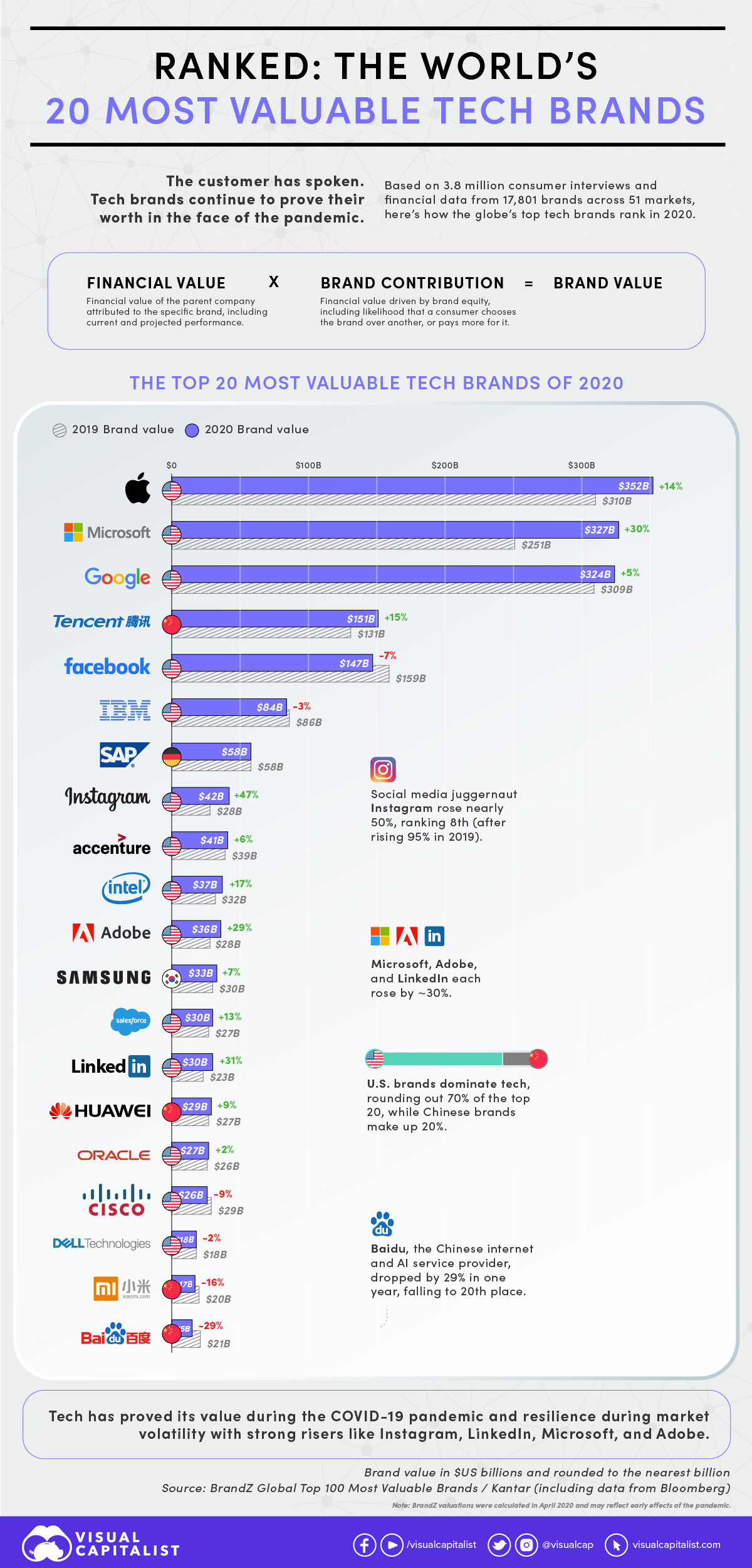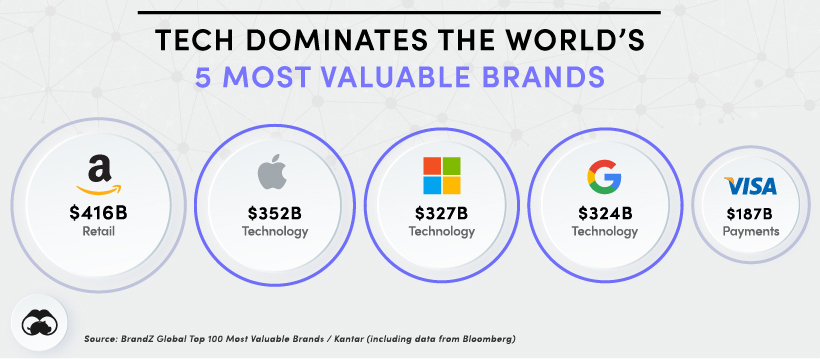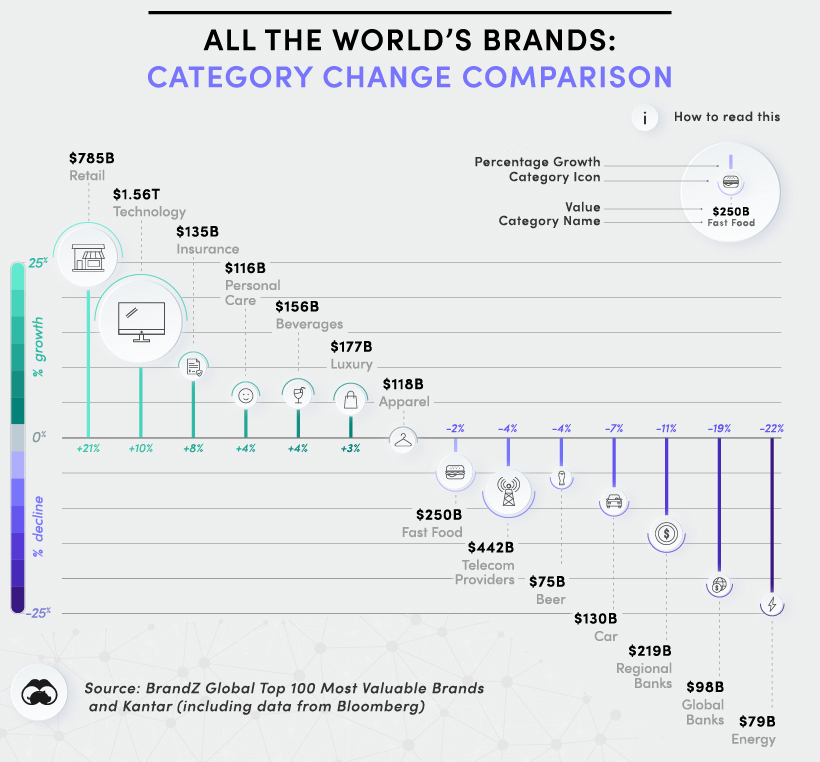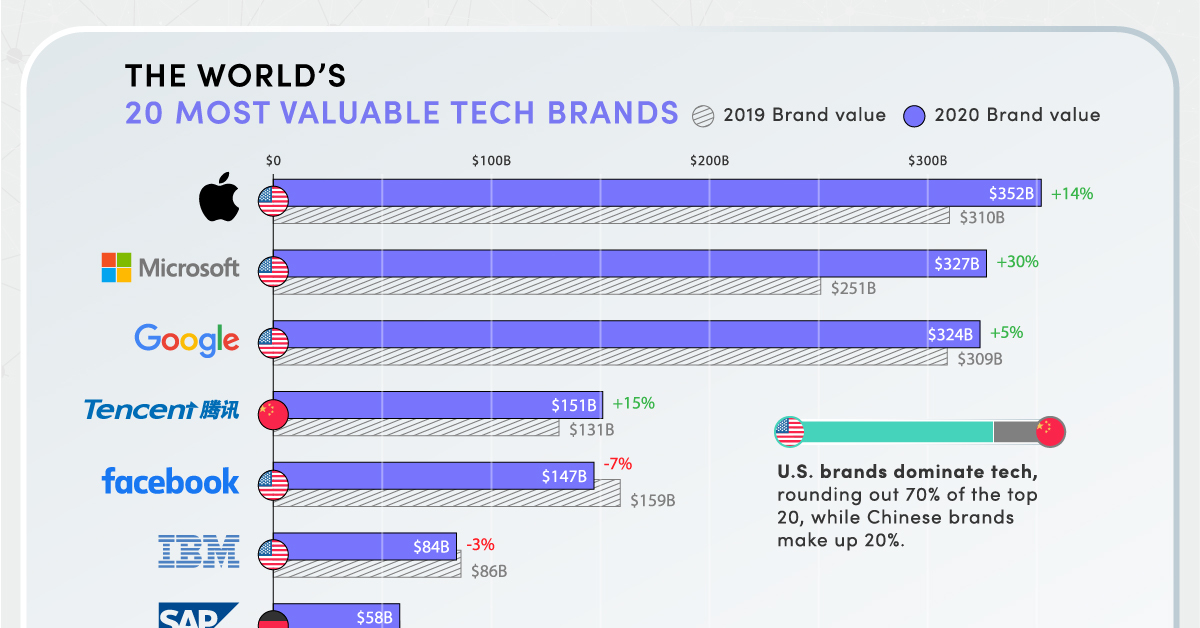Technology
The World’s Tech Giants, Ranked by Brand Value

The World’s Tech Giants, Ranked by Brand Value
The pandemic has businesses everywhere on the ropes, with many firms filing for bankruptcy since lockdowns began. Despite the uncertainty, tech giants and major digital retail brands are still thriving—and some are running circles around those that are less pandemic-proof.
Using data from Kantar and Bloomberg, a recent brand report released by BrandZ shows which tech companies are proving their worth to consumers during COVID-19 chaos. With data covering almost 4 million consumers, BrandZ also reveals that the tech sector leads the world’s 100 most valued brands in terms of financial power and consumer sentiment.
Here’s how the top 20 tech brands from the report stack up:
| Rank | Company | Brand Value (2020) | Change (%) |
|---|---|---|---|
| #1 | 🇺🇸 Apple | $352 billion | +14% |
| #2 | 🇺🇸 Microsoft | $327 billion | +30% |
| #3 | $324 billion | +5% | |
| #4 | 🇨🇳 Tencent | $151 billion | +15% |
| #5 | $147 billion | -7% | |
| #6 | 🇺🇸 IBM | $84 billion | -3% |
| #7 | 🇩🇪 SAP | $58 billion | 0% |
| #8 | $42 billion | +47% | |
| #9 | 🇺🇸 Accenture | $41 billion | +6% |
| #10 | 🇺🇸 Intel | $37 billion | +17% |
| #11 | 🇺🇸 Adobe | $36 billion | +29% |
| #12 | 🇰🇷 Samsung | $33 billion | +7% |
| #13 | 🇺🇸 Salesforce | $30 billion | +13% |
| #14 | $30 billion | +31% | |
| #15 | 🇨🇳 Huawei | $29 billion | +9% |
| #16 | 🇺🇸 Oracle | $27 billion | +2% |
| #17 | 🇺🇸 Cisco | $26 billion | -9% |
| #18 | 🇺🇸 Dell | $18 billion | -2% |
| #19 | 🇨🇳 Xiaomi | $17 billion | -16% |
| #20 | 🇨🇳 Baidu | $15 billion | -29% |
Out of the top five tech brands, Microsoft made the biggest moves with 30% brand value growth. Other big movers in the top 20 were Instagram (owned by Facebook), Adobe, and LinkedIn (owned by Microsoft), rising 47%, 29%, and 31%, respectively.
Broken down by nation, U.S. brands are dominating tech’s heavy hitters, claiming 14 of the world’s top 20 tech brands. Chinese brands round out much of the remaining top 20, including tech entertainment and social media giant Tencent, which rose 15% in brand value since 2019.
Big Tech’s Heavyweights
Tech’s top brands are raking in billions of dollars, capturing consumer mindshare, captivating people, and comforting them during volatile months. Apple, Microsoft, Google, Tencent, and Facebook—tech’s leading contingent—have made those moves look easy during what are rough times for many world brands.
While most tech brands in the upper half of the top 20 saw significant increases in brand value, only Facebook and IBM were in decline from 2019, at -7% and -3% respectively. The biggest loss in tech’s top 20 came from China’s Baidu, which fell by -29% in 2020.
Waning consumer trust, thanks in part to the perceived misuse of personal data, is a gap that tech’s popularity alone won’t fill forever. (Following the Cambridge Analytica scandal, nearly 25% of Facebook account holders reported being “extremely” or “very” concerned about their personal data.)
Pandemic-Proof Applications
Coming in at eighth place, Facebook-owned Instagram gained 47% in brand value—a huge percentage, but less than the whopping 95% growth it had in 2019.
On the whole, digital apps have been faring well during the pandemic, especially those built for entertainment, shopping, social connection, and delivery.
These brands had anticipated, even invented, the online-offline dynamics of modern life that became indispensable for survival during the lockdown homebound weeks of avoiding the contagion.
— BrandZ 2020 Global Top 100 Report
Top Brands, by Category
While the brand value growth rates of tech giants aren’t entirely immune to the effects of COVID-19, the likes of Apple, Microsoft, and Google are growing steadily, surpassed only by e-commerce leader Amazon.
With data collected into April 2020, BrandZ’s report on the world’s top 100 brands reflects multiple shifting needs and consumer concerns at a categorical scale.

While consumer affinity for e-commerce and social media brands has increased, fast food and beer brands took a hit, despite reports of increased alcohol consumption and food delivery during lockdown. It would seem then, that consumers have been valuing their tools and means of consumption.
Of the report’s 14 brand categories, only six increased in value, mostly by less than 5%. Of the top risers, six were tech brands and six were mainly e-commerce.
Other upwardly mobile brands were those in the apparel and personal care categories. Much like retail, those categories had an increasing reliance on technology to deliver their products.

The above chart shows overall categorical changes for 2020 led by retail, tech, and insurance. In the opposite corner, energy, and bank brands took the biggest hits.
Rolling with the Punches
The economic impacts of COVID-19 are undeniable. Even still, BrandZ’s top 100 brands marked a steady increase of 6% in value in 2020, compared to 7% the previous year.
This pandemic has offered up era-defining change, with tech and e-commerce seizing the day. But in a climate where nothing can be taken for granted, brands large and small are still taking their knocks.
For now, the brands that are embraced by consumers will be those that can apply a salve to the blows that 2020 keeps delivering.
Technology
Visualizing AI Patents by Country
See which countries have been granted the most AI patents each year, from 2012 to 2022.

Visualizing AI Patents by Country
This was originally posted on our Voronoi app. Download the app for free on iOS or Android and discover incredible data-driven charts from a variety of trusted sources.
This infographic shows the number of AI-related patents granted each year from 2010 to 2022 (latest data available). These figures come from the Center for Security and Emerging Technology (CSET), accessed via Stanford University’s 2024 AI Index Report.
From this data, we can see that China first overtook the U.S. in 2013. Since then, the country has seen enormous growth in the number of AI patents granted each year.
| Year | China | EU and UK | U.S. | RoW | Global Total |
|---|---|---|---|---|---|
| 2010 | 307 | 137 | 984 | 571 | 1,999 |
| 2011 | 516 | 129 | 980 | 581 | 2,206 |
| 2012 | 926 | 112 | 950 | 660 | 2,648 |
| 2013 | 1,035 | 91 | 970 | 627 | 2,723 |
| 2014 | 1,278 | 97 | 1,078 | 667 | 3,120 |
| 2015 | 1,721 | 110 | 1,135 | 539 | 3,505 |
| 2016 | 1,621 | 128 | 1,298 | 714 | 3,761 |
| 2017 | 2,428 | 144 | 1,489 | 1,075 | 5,136 |
| 2018 | 4,741 | 155 | 1,674 | 1,574 | 8,144 |
| 2019 | 9,530 | 322 | 3,211 | 2,720 | 15,783 |
| 2020 | 13,071 | 406 | 5,441 | 4,455 | 23,373 |
| 2021 | 21,907 | 623 | 8,219 | 7,519 | 38,268 |
| 2022 | 35,315 | 1,173 | 12,077 | 13,699 | 62,264 |
In 2022, China was granted more patents than every other country combined.
While this suggests that the country is very active in researching the field of artificial intelligence, it doesn’t necessarily mean that China is the farthest in terms of capability.
Key Facts About AI Patents
According to CSET, AI patents relate to mathematical relationships and algorithms, which are considered abstract ideas under patent law. They can also have different meaning, depending on where they are filed.
In the U.S., AI patenting is concentrated amongst large companies including IBM, Microsoft, and Google. On the other hand, AI patenting in China is more distributed across government organizations, universities, and tech firms (e.g. Tencent).
In terms of focus area, China’s patents are typically related to computer vision, a field of AI that enables computers and systems to interpret visual data and inputs. Meanwhile America’s efforts are more evenly distributed across research fields.
Learn More About AI From Visual Capitalist
If you want to see more data visualizations on artificial intelligence, check out this graphic that shows which job departments will be impacted by AI the most.
-

 Markets1 week ago
Markets1 week agoU.S. Debt Interest Payments Reach $1 Trillion
-

 Markets2 weeks ago
Markets2 weeks agoRanked: The Most Valuable Housing Markets in America
-

 Money2 weeks ago
Money2 weeks agoWhich States Have the Highest Minimum Wage in America?
-

 AI2 weeks ago
AI2 weeks agoRanked: Semiconductor Companies by Industry Revenue Share
-

 Markets2 weeks ago
Markets2 weeks agoRanked: The World’s Top Flight Routes, by Revenue
-

 Countries2 weeks ago
Countries2 weeks agoPopulation Projections: The World’s 6 Largest Countries in 2075
-

 Markets2 weeks ago
Markets2 weeks agoThe Top 10 States by Real GDP Growth in 2023
-

 Money2 weeks ago
Money2 weeks agoThe Smallest Gender Wage Gaps in OECD Countries















